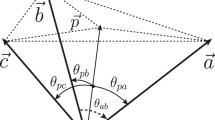Abstract
In the first part of this work, an attempt of a realistic interpretation ofquantum logic is presented. Propositions of quantum logic are interpreted as corresponding to certain macroscopic objects called filters; these objects are used to select beams of particles. The problem of representing the propositions as projectors in a Hilbert space is considered and the classical approach to this question due to Birkhoff and von Neumann is criticized as neglecting certain physically important properties of filters. A new approach to this problem is proposed.
The second part of the paper contains a revision of the concept of a state in quantum mechanics. The set of all states of a physical system is considered as an abstract space with a geometry determined by the transition probabilities. The existence of a representation of states by vectors in a Hilbert space is shown to impose strong limitations on the geometric structure of the space of states. Spaces for which this representation does not exist are called non-Hilbertian. Simple examples of non-Hilbertian spaces are given and their possible physical meaning is discussed. The difference between Hilbertian and non-Hilbertian spaces is characterized in terms of measurable quantities.
Similar content being viewed by others
References
Dirac, P. A. M.: Principles of quantum mechanics. Oxford: Clarendon Press 1958.
Birkhoff, G.: Lattice theory, New York: Am. Math. Soc. 1967.
—— Ann. Math.36, 743–748 (1935).
——, andJ. von Neumann: Ann. Math.37, 823–843 (1936).
Mackey, G. W.: The mathematical foundations of quantum mechanics. New York: W. A. Benjamin Inc. 1963.
Jauch, J. M., andC. Piron: Helv. Phys. Acta36, 827–837 (1963).
Piron, C.: Helv. Phys. Acta37, 439–468 (1964).
Finkelstein, D., J. M. Jauch, S. Schimonowich, andD. Speiser: Foundations of quaternionic quantum mechanics. J. Math. Phsy.3, 207 (1962); — Some physical consequences of general Q-covariance. J. Math. Phys.4, 788 (1963).
Finkelstein, D.: The logic of quantum physics. N. Y. Acad. Sci.1963, 621–637.
Schwinger, J.: Quantum mechanics (Lectures at the Summer School, Les Houches, 1955).
Pool, J. C. T.: Simultaneous observability and the logic of quantum mechanics, Univ. of Iowa, Ph. D. thesis, Department of Physics Report No. 12.
Ramsay, A.: J. Math. Mech.15, 277 (1966).
Gunson, J.: Commun. Math. Phys.4, 262 (1967).
Author information
Authors and Affiliations
Rights and permissions
About this article
Cite this article
Mielnik, B. Geometry of quantum states. Commun.Math. Phys. 9, 55–80 (1968). https://doi.org/10.1007/BF01654032
Received:
Issue Date:
DOI: https://doi.org/10.1007/BF01654032




